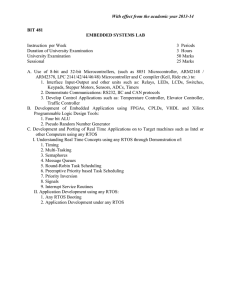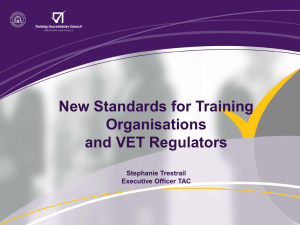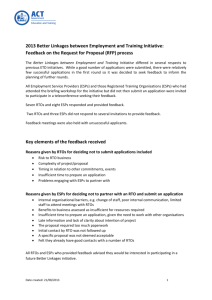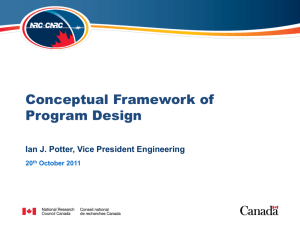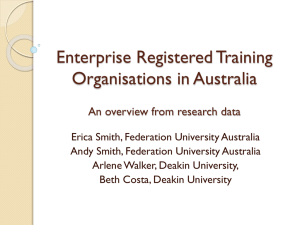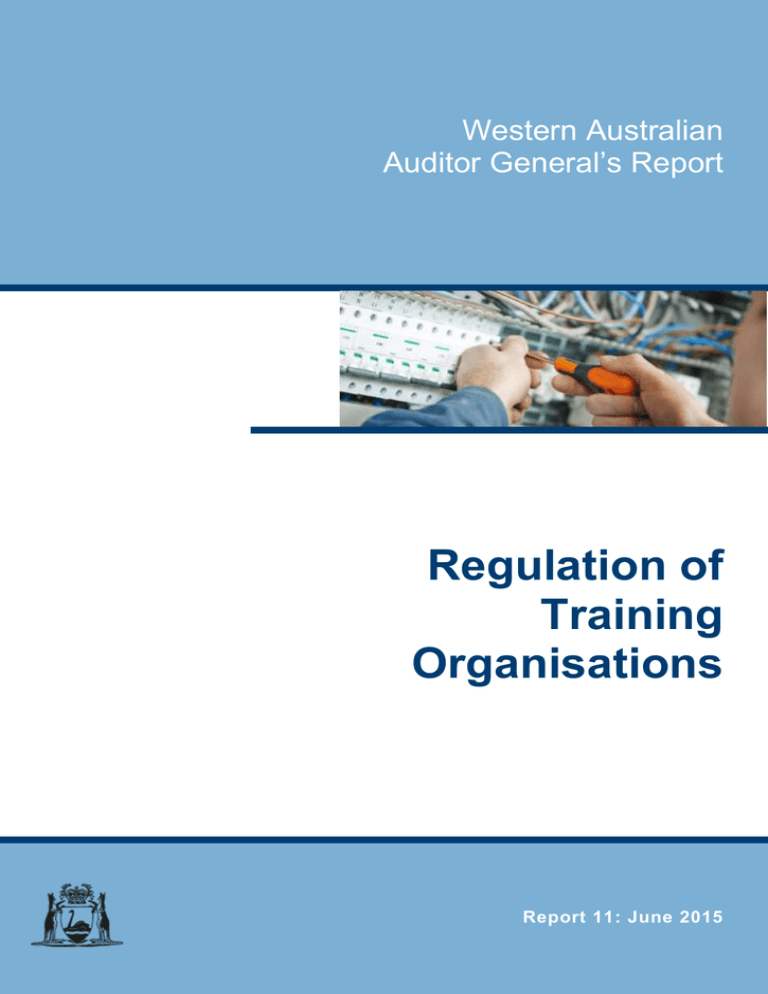
Western Australian
Auditor General’s Report
Regulation of
Training
Organisations
Report 11: June 2015
Office of the Auditor General
Western Australia
7th Floor Albert Facey House
469 Wellington Street, Perth
Mail to:
Perth BC, PO Box 8489
PERTH WA 6849
T: 08 6557 7500
F: 08 6557 7600
E: info@audit.wa.gov.au
W: www.audit.wa.gov.au
National Relay Service TTY: 13 36 77
(to assist people with hearing and voice impairment)
On request, we can deliver this report in alternative
format for those with visual impairment.
© 2015 Office of the Auditor General Western Australia. All
rights reserved. This material may be reproduced in whole or
in part provided the source is acknowledged.
ISSN 2200-1913 (Print)
ISSN 2200-1921 (Online)
WESTERN AUSTRALIAN AUDITOR GENERAL’S REPORT
Regulation of Training Organisations
Report 11
June 2015
THE PRESIDENT
LEGISLATIVE COUNCIL
THE SPEAKER
LEGISLATIVE ASSEMBLY
REGULATION OF TRAINING ORGANISATIONS
This report has been prepared for submission to Parliament under the provisions of section 25
of the Auditor General Act 2006.
Performance audits are an integral part of the overall audit program. They seek to provide
Parliament with assessments of the effectiveness and efficiency of public sector programs and
activities, and identify opportunities for improved performance.
This audit assessed whether the Training Accreditation Council could provide assurance that
Registered Training Organisations (RTO) deliver quality training and assessment of student
skills.
My report found the Council is checking RTOs in accordance with agreed national standards.
It included a review of a sample of 18 of the Council’s RTO checks.
The Council offers some assurance that non-compliance will be identified and fixed, however
more than half the checks the Council performed in 2013-14 found non-compliance with the
national standards. Cases of non-compliance by RTOs raises concern that students may not
get the training they need and that industry expects.
I wish to acknowledge the staff at the Training Accreditation Council for their cooperation with
this audit.
COLIN MURPHY
AUDITOR GENERAL
24 June 2015
Contents
Auditor General’s Overview ........................................................................................ 4
Executive Summary .................................................................................................... 5
Introduction .................................................................................................................. 5
Overview ...................................................................................................................... 5
Audit Conclusion .......................................................................................................... 6
Key Findings ................................................................................................................ 6
Recommendations ....................................................................................................... 7
Response from the Training Accreditation Council ....................................................... 8
Audit focus and scope ................................................................................................ 9
Background .............................................................................................................. 10
The checks of whether RTOs comply with the standards could be better targeted at
risk ............................................................................................................................ 12
Many RTOs do not comply with training standards which increases the risk of poor
quality training .......................................................................................................... 13
Targeted monitoring and industry engagement would improve compliance .................15
The Council uses sanctions as a last resort, but this poses risks to students and
industry ..................................................................................................................... 16
Students and industry are not told when training has been deficient ...........................17
Appendix 1: Regulation of Registered Training Organisations (RTO) ...................... 18
Regulation of Training Organisations | 3
Auditor General’s Overview
The Vocational Education and Training sector provides students with
pathways to employment and higher education. With more than 100 000
students enrolled in VET courses, it is an important sector of the WA
economy. Students that enrol in a VET course need to have confidence they
will get the training they need and that they will not suffer financial loss if an
RTO is not viable. A recent example in Victoria where a training provider
cancelled over 1000 certificates it had issued and repaid at least $8 million in
government money is a timely reminder of the considerable risks.
The Training Accreditation Council is responsible for registering WA training providers and
assuring they deliver quality services. It does this through the registration of providers and
checking those it has registered to confirm that they are complying with national standards. It
can also sanction those who fail to comply with standards. As such, its role is essential to
building confidence in the sector and ensuring students get the best outcomes.
I was concerned to find that the Council’s checking has shown a high level of non-compliance
amongst RTOs. The Council should improve its practices to find these problems early and to
ensure they are fixed quickly to minimise the impact on students and industry.
But I am encouraged by new measures approved by the Council in April 2015 that will focus
more on higher risk RTOs and engagement with industry. These measures should result in
better compliance by training providers to the benefit of students and industry.
4 | Western Australian Auditor General
Executive Summary
Introduction
This report assessed whether the Training Accreditation Council (Council) can provide
assurance that Registered Training Organisations (RTO) deliver quality training and
assessment of student skills. We focused on the Training Accreditation Council’s monitoring
of RTOs during 2013 and 2014 and whether it took appropriate action when it identified
problems with their performance.
Overview
Vocational education and training (VET) contributes to Western Australia’s (WA) economic
development by providing students with pathways to higher education and employment. VET
delivers skills in a diverse range of trades and professions. In 2013-14 around $550 million
was spent in WA in the VET sector.
Across Australia around 5 000 training organisations deliver vocational training for more than
1 600 nationally recognised qualifications, from building and construction to aged care and
financial services. These qualifications cover about 85 per cent of occupations.
Before they can deliver nationally recognised vocational courses, training organisations must
first register as an RTO.
There are about 500, mostly private, RTOs based in WA, of which 328 are regulated by the
Council. The rest are generally regulated by a national body because they train international
students or deliver training in multiple states.
In 2009, the WA Government agreed that the Council would follow the national approach to
regulating RTOs. This means that all RTOs across Australia must meet the same set of
conditions and standards1 for the courses they deliver. These aim to ensure that RTOs deliver
consistent quality training and skill assessment that meet the needs of industry. The national
approach is prescriptive in how the Council must regulate RTOs. However, changes came into
effect in January 2015 that allow the Council to better focus its regulatory effort. These changes
did not apply for the period examined by this audit but were considered when making our
recommendations.
To be registered, RTOs must comply with the conditions and standards. These cover things
like being managed by a ‘fit and proper’ person, financial viability, having public liability
insurance, as well as making sure the training they deliver meets the national approach for the
relevant qualification. They also cover course material, how it is to be delivered, and the
competence of trainers.
The Council registers RTOs and checks that they meet the requirements and comply with the
standards. This includes stopping new organisations from entering the market and RTOs from
expanding their operations if they do not meet the standards. The Council does mandatory
checks prior to initial registration, a year later, and then every five years. The Council uses
contract auditors to do these checks.
Once checked, RTOs are found to be compliant or non-compliant. Non-compliance can be
minor, significant or critical. RTOs are given time to fix any non-compliance before the Council
resorts to available sanctions. These range from suspending through to cancelling an RTO’s
1
Essential Conditions and Standards for Initial Registration and the Essential Conditions and Standards for Continuing
Registration. These were changed in January 2015 and became the Standards for Registered Training Organisations 2015.
Regulation of Training Organisations | 5
registration. The sanctions aim to ensure RTO compliance and protect current and future
students and industry.
Although the Council’s regulatory role is important to ensuring the quality of training, other
factors also play a part, such as the nature of the industry, the national regulatory approach
and RTOs themselves. We only assessed the Council’s role in ensuring training quality.
The Council spends about $3 million a year registering and checking RTOs.
Audit Conclusion
The Training Accreditation Council follows the national approach in how it regulates RTOs.
This includes deciding which RTOs to register, checking compliance, and when to sanction
RTOs that do not comply.
The Council’s activities restrict registration to eligible RTOs and offers some assurance that
non-compliance will be identified and fixed. In 2013-14 more than half of the Council’s checks
found non-compliance with the national standards. As a result of the Council’s work, most
problems that led to non-compliance were fixed.
Non-compliance by RTOs raises concern that students may not get the training they need and
industry expects. The Council is concerned about the high rate of RTO non-compliance and is
working on ways to improve compliance and reduce the risks to students and industry.
Key Findings
The Training Accreditation Council is checking RTOs in accordance with agreed national
standards. Checks were completed in line with assessed risk, and decisions were reliable
and transparent.
In 2013-14, the Council did 323 checks of RTOs and found 35 per cent were either
significantly or critically non-compliant with the national standards. Another 22 per cent was
assessed as minor non-compliance. In the sample of 18 checks we reviewed, the Council
assessed 14 RTOs as non-compliant of which five were significantly non-compliant and four
were critically non-compliant. Examples include:
o
lack of evidence of student assessment
o
unqualified trainers
o
no assessment of the practical application of skills when it was required
o
an RTO passing students despite their written assessments showing incorrect or
incomplete answers.
These issues raise concerns about the quality of training, the consequence for students,
and the confidence that industry can have in RTOs. The Council has identified this as an
area of concern and is working on a revised regulatory approach that will give greater focus
to RTOs the Council assess as higher risk.
It was generally not evident that the Council considered the risks from an RTO’s noncompliance or the need to notify students or industry, even when critical non-compliance
had occurred. Critical non-compliance poses a risk that students may not have the skills to
work in their chosen vocation, and industry may employ staff not properly trained. Notifying
students and industry extends beyond the national approach. However, in our view, the
Council should consider and document its assessment of the impact of critical noncompliance and if students and industry should be notified.
6 | Western Australian Auditor General
In our sample of 18 checks the Council did not:
o
use industry advisers to plan and conduct the eight post-registration mandatory checks.
Doing so would add value when RTOs deliver technical or specialised training and
would allow the Council to focus these checks on industry concerns
o
routinely consider whether to speak with students. Auditors only spoke with students
during three of the 18 checks we reviewed. Talking with students will not always add
value. But in some instances it would help verify the quality of training and assessments
and could help identify non-compliance, like in the eight post-registration mandatory
checks we reviewed
o
carry out random checks without notice of RTO training and assessment. The national
approach does not allow checks without notice. This affected the Council’s capacity to
regulate high risk RTOs.
During 2013-14 the Council applied sanctions to suspend, vary or cancel the registration of
nine RTOs. In all nine instances, the proper internal processes were followed and the
Council’s decision to sanction appeared consistent with the problems identified.
Recommendations
The Training Accreditation Council should:
within 12 months, fully implement its revised approach to regulating RTOs. This
should focus on high risk RTOs and ways to increase compliance in the sector
seek industry input when it plans and conducts its mandatory checks of RTOs. This
would better focus checks on industry concerns
develop clear requirements for when its contract auditors should talk with students
to verify the quality of training and assessments
consider the need for legislative or policy change to allow the Council to check RTO
compliance without prior notice. The threat of unannounced checks might help
ensure RTOs stay compliant with the standards
explicitly consider and document the risk to students and industry of training
provided by non-compliant RTOs, and any decisions made. In addition, find ways to
reduce timeframes before sanctioning an RTO to reduce the risk that students
receive inadequate training.
Regulation of Training Organisations | 7
Response from the Training Accreditation Council
The Council’s role is to assure the quality of training and assessment of RTOs or applicants
to be RTOs through:
the restriction of entry and/or expansion in the marketplace of applicants that have not
demonstrated compliance with the national standards; and
the ongoing effective identification of non-compliance, to ensure that RTOs amend their
practices to comply with the requirements of the national standards or are removed from
the marketplace.
The Council is committed to ensuring that only training providers that meet the national
quality standards enter and remain in the marketplace. The Council undertook 323 audits in
2013-14 based on the Councils assessment of risk. The outcome of 145 of these audits was
that 57% of applicants were restricted from entering or expanding into the marketplace, prior
to there being any risk to students and industry. The 142 audits of RTOs operating within
the marketplace were targeted at the highest levels of risk, and non-compliant RTOs were
required to fix the problems or had their registration cancelled. As outlined in this report, as
a result of the Council’s work most problems that led to non-compliance were fixed.
The Council is pleased that the audit acknowledges that the Council undertakes its function
in line with the nationally agreed standards, in line with assessed risk and that the decisions
of the Council are reliable and transparent.
The introduction of the Standards for VET Regulators 2015 will further allow the Council to
focus regulatory effort on the highest levels of risk and enable more appropriate regulatory
responses. The Council’s new targeted Risk Assessment Framework is intended to provide
further assurance that RTOs deliver quality training and assessment to students.
Recommendation 1 – Accepted. The Council will implement the Risk Management
Framework endorsed at its April 2015 meeting over the next 12 months. The Framework
will focus on holistic risk assessment at industry and individual RTO level, to identify the
highest levels of risk considering intelligence from industry consultation and product risk
assessment, provider indicators and complaints management.
Recommendation 2 – Accepted. The Council’s existing Industry Consultation Strategy will
be strengthened through the implementation of the Council’s new Risk Management
Framework. The Framework prescribes the ongoing incorporation of industry advice to
inform the overarching audit strategy as well as informing the audit of individual RTOs.
Recommendation 3 – Accepted. The Council’s current requirement to interview students
when contact will add value to the audit process will be reviewed to articulate mandatory
circumstances when auditors must conduct student interviews.
Recommendation 4 – Accepted. The Council will undertake initial research to inform
consideration of a policy position on the conduct of RTO compliance audits without prior
notice.
Recommendation 5 – Accepted. The Council will review its policy to make its consideration
of risk more explicit. The Council will also review options to reduce timeframes for the
application of sanctions.
8 | Western Australian Auditor General
Audit focus and scope
The objective of the audit was to assess whether the Training Accreditation Council can
provide assurance that Registered Training Organisations (RTOs) deliver quality training and
assessment services.
The audit focused on two lines of inquiry:
Does the Training Accreditation Council appropriately assess the quality of provider training
and assessment?
Does the Training Accreditation Council take appropriate action when RTOs are assessed
as not delivering quality training or assessment services?
Our audit assessed the Council’s regulatory activities against the Essential Conditions and
Standards for Initial Registration and the Essential Conditions and Standards for Continuing
Registration. These were changed in January 2015 and became the Standards for Registered
Training Organisations 2015.
As part of the audit, we:
reviewed a sample of 18 of the Council’s RTO checks (including mandatory post-registration
checks, compliance monitoring checks, and applications to expand RTO operations), 22 of
the Council’s RTO risk assessments, all nine sanctioned RTOs, and other Council records
assessed how the Council monitors the work of its contracted auditors
interviewed Council secretariat staff and some of its contracted auditors
attended a Council check as an observer
consulted with industry stakeholders.
We did not check the quality of training and assessments delivered by RTOs. Rather we looked
at the checks of this done by the Council during 2013 and 2014 using its contract auditors. We
also did not audit any other bodies that contribute to or influence training quality.
We conducted the audit in accordance with Australian Auditing and Assurance Standards.
Regulation of Training Organisations | 9
Background
The vocational education and training (VET) sector in WA is regulated by both a national and
state body:
WA’s Training Accreditation Council (Council) is an independent statutory body that
regulates most WA based training organisations. Its functions are set out in the Vocational
Education and Training Act 1996 (the Act) and the Vocational Education and Training
(General) Regulations 2009
other RTOs are regulated by a national body, the Australian Skills Quality Authority.
In 2009, the WA Government agreed that the Council would follow the national approach to
regulating RTOs. This provides a consistent approach to regulation and means that all
Australian RTOs must meet the same standards. The national approach is prescriptive in how
the Council must regulate RTOs. However, changes that came into effect in January 2015
allow the Council more flexibility in how it regulates RTOs. These changes did not apply at the
time of our audit but were considered when making our recommendations.
To be registered, RTOs are required to comply with national conditions and standards2. These
are set out in the Australian Quality Training Framework. The Framework’s focus is on training
and assessment, client services and management systems.
The Council is required to conduct mandatory checks of RTOs against the standards prior to
initial registration, within one year of initial registration3, and every five years after registration.
Checks are triggered by the passing of set times or a specific event, for example if a complaint
is made against an RTO, or if an RTO wants to offer a new course.
Their assessments focus on:
initial registration
o
demonstration of ‘preparedness’ to deliver quality training and assessment services
continuing registration
o
the ‘actual’ quality of training and assessment systems and tools and their use by the
RTO when training students
o
that RTOs are providing appropriate training and assessments for the training courses
it is registered to deliver
o
ensuring that qualifications are only awarded to people who have been assessed as
having attained the competency (skills, knowledge and ability) required by the training.
It is important to note that the Council’s role does not include reassessing the skills of students.
For more information on this process, see Appendix 1 on page 18.
2
3
Essential Conditions and Standards for Initial Registration and the Essential Conditions and Standards for Continuing
Registration. These were changed in January 2015 and became the Standards for Registered Training Organisations 2015.
The Standards for Registered Training Organisations 2015 changed this to within 24 months of initial registration.
10 | Western Australian Auditor General
The assessments result in a compliance finding for each RTO. Findings range from compliant
through to critically non-compliant, as shown in Figure 1 below. Critical non-compliance
includes the risk of injury or death to students and/or staff in the training environment or the
current (or future) workplace.
Compliant
Minor
non-compliance
Significant
non-compliance
Critical
non-compliance
Source: OAG
Figure 1: Compliance findings used by the Council
When RTOs do not comply with the conditions and standards, the Council can apply a number
of sanctions available under the Act. The sanctions aim to enforce compliance and protect
students and industry.
Available sanctions are:
suspend the registration. This means the training organisation cannot call itself an RTO or
issue nationally recognised qualifications, until it is compliant with the standards
vary the registration. For example, it can specify which courses the RTO cannot offer to
students
cancel the registration. This means the training organisation can no longer call itself an RTO
and cannot issue nationally recognised qualifications to students.
A national register provides information about the status of all RTOs. This is publicly available
at https://training.gov.au/Search/SearchOrganisation.
Section 58E of the Act also gives the Council the power to cancel student qualifications. For
example, if a qualification was incorrectly awarded due to an administrative error or arising
from fraudulent behaviour.
Regulation of Training Organisations | 11
The checks of whether RTOs comply with the
standards could be better targeted at risk
The Council is following the national approach for regulating RTOs. It checks that RTOs meet
the national standards for registration in how they plan and implement their training and in their
assessment of students. This supports the national recognition of qualifications issued by
RTOs.
The national approach requires the Council to register compliant RTOs for a period of up to
five years. Before each period of registration expires, an RTO must reapply for registration.
Our review of 18 checks confirms the Council did them when required. Checks were done for
the RTOs’ initial registration, 12 months later and five-year renewal registration. The Council
checks that an RTO complies with the conditions and standards for delivering training in the
courses it wants to offer. It also checks an RTO when a triggering event arises, such as when
it wants to offer a new course.
Regulation by the Council included making sure:
an RTO was financially viable, met the criteria for operating in WA and had appropriate
governance arrangements
the content and delivery of training and assessments met the national approach for the
relevant qualification.
At the time of our audit, the national approach to checking compliance was inflexible as it
depended on the passing of a set time, or a triggering event. It did not allow the Council to
regulate RTOs based on the assessed risk of non-compliance, or the impact on students and
industry. Therefore, even though the Council performed risk assessments of RTOs, these
assessments did not influence when or how often the Council checked RTOs. The Council
recognises that this limits additional checks of RTOs it assesses as higher risk and is working
toward improving its regulatory approach.
We also reviewed a separate sample of 22 of the Council’s RTO risk assessments. We found
that these assessments were in line with the AQTF National Guideline for Risk Management.
The Council assessed all the risk indicators, assigned the application a risk finding, and carried
out more in-depth checks on RTOs rated as higher risk. However, the risk assessment did not
influence how often the Council would check the RTO in the future.
The Council considers the following factors when deciding if an RTO is a risk:
if there are indications of past performance issues, such as previous non-compliance with
standards, or complaints about the RTO
the RTOs financial viability, and governance factors such as transparency of ownership
the potential impact of the RTO failing to meet the expected standards. For example,
whether the RTO trains students who are under 18 years of age, whether it accepts fees in
advance, and whether it trains students in qualifications that could lead to a licence to do
certain kinds of work, such as electrical work.
We found the decisions the Council made were transparent and reliable. Specifically, decisions
about whether to register or check an RTO were well documented and made by persons with
delegated authority.
12 | Western Australian Auditor General
Many RTOs do not comply with training standards
which increases the risk of poor quality training
The Council did 323 checks in 2013-14 and found 60 per cent were non-compliant with the
national standards. Thirty-five per cent were significant or critical non-compliance and
22 per cent were minor non-compliance. The other three per cent non-compliance related to
course accreditation. These high rates raise concerns about the impact of non-compliance on
training outcomes for students.
Non-compliance will not always affect students and industry. For example, when the Council
finds non-compliant applications for registration or for expanding RTO operations. This is
because the Council finds the non-compliance prior to any delivery of training. This was the
case for around half of the Council’s checks in 2013-14.
Fourteen of the 18 checks we reviewed found non-compliance (Table 1). We found that seven
of the instances of significant or critical non-compliance could have had an impact on students.
The seven checks were either post-registration mandatory checks or compliance monitoring
checks of RTOs that were training students.
Number of checks
Impact on learners and/or
other consumers of goods and
services produced in the
training environment or the
current (or future) workplace
Compliance
Minor noncompliance
Significant
noncompliance
Critical noncompliance
4
5
5
4
N/A
None or minor
adverse
impact
Indications of
a significant
adverse
impact
Critical
adverse
impact is
occurring or
has occurred
Source: OAG and the Council
Table 1: Findings from our review of 18 checks
Regulation of Training Organisations | 13
Examples of non-compliance we saw are shown in Figure 2.
Source: OAG and the Council
Figure 2: Examples of non-compliance
The Council must deal with non-compliance in line with the national approach. This includes
allowing an RTO to continue to operate while it fixes problems, and applying sanctions to limit
operations and encourage compliance. The Council can suspend, vary, or cancel an RTO’s
registration.
In the records we looked at, RTOs took up to six months to become compliant. Figure 3 below
shows how a non-compliant RTO can continue to operate while it fixes non-compliance.
In December 2013, the Council checked an RTO and found a number of problems. These included
having deemed a group of students competent in a first aid unit, without any evidence that they had
been assessed.
Under the national approach the RTO was allowed to operate while it fixed the problems. In
February 2014 the problems had not been fixed and the Council found the RTO to be significantly
non-compliant.
In April 2014 the RTO was able to show the Council that it was appropriately assessing students in
the first aid unit.
Other non-compliance issues were fixed by June 2014.
Source: OAG and the Council
Figure 3: Example of an RTO allowed to operate while non-compliant
14 | Western Australian Auditor General
None of the 14 non-compliant checks in our sample (Table 1) resulted in sanctions against
RTOs. This is because problems were either fixed within permitted timeframes, or sanctions
were not applicable because the Council found the problems during its pre-registration and
other approval processes. By allowing RTOs to fix problems, the national approach aims to
reduce any unnecessary impact on students.
We reviewed the Council’s use of sanctions in 2013-14. We discuss our findings later in this
report.
Targeted monitoring and industry engagement would
improve compliance
The Council’s current regulatory activities have found high levels of non-compliance amongst
RTOs. But an approach focused on industry and student concerns could better use the
Council’s resources, and detect non-compliance not currently identified. Specifically, the way
the Council plans and conducts its mandatory checks did not involve:
random or targeted checks without notice of RTO training and assessment. This would allow
the Council to see how RTOs operate in practice without having had a chance to prepare
for the checks. The Council advised that the national approach does not allow checks
without notice. It intends to explore their use and if any change to legislation is required
auditors routinely speaking with students. Auditors only spoke with students during two of
the eight post-registration mandatory checks we reviewed. Talking with students will not
always add value but in some instances would help verify the quality of training and
assessments and could help identify non-compliance
the use of advisers from industry in any of the eight post-registration mandatory checks we
reviewed. As part of our audit we spoke with five of the Council’s key industry stakeholders
including WorkSafe and the Department of Mines and Petroleum (Dangerous Goods
Safety). One stakeholder wanted the Council to use technical advisors when checking high
risk RTOs.
The Council advised that while the national approach does not require the use of industry
advisors, it does seek stakeholder input into its targeted industry audits, such as into the aged
care sector. Further, the past availability of industry advisers has limited their use.
In April 2015, the Council revised its approach to risk management. The new approach allows
the Council to consider RTO and industry risk factors in deciding how it will regulate individual
RTOs and industries. For example, mandatory checks will better address risk factors specific
to each RTO through greater industry consultation.
Regulation of Training Organisations | 15
The Council uses sanctions as a last resort, but this
poses risks to students and industry
The Council often finds that RTOs are significantly or critically non-compliant with the national
standards. If RTOs fix problems within permitted timeframes then sanctions are not required.
But, the longer it takes RTOs to fix problems the greater the risks.
In half of the 18 checks we reviewed, the Council assessed the RTO as significantly or critically
non-compliant. The Council followed the national approach in dealing with this noncompliance. This included giving RTOs time to fix problems. Sanctions were not required and
no students were displaced.
Sanctions are rarely used. In 2013-14, the Council found non-compliance in 194 of the 323
checks it did. In the same year, it applied sanctions to nine RTOs4.
All nine RTOs had input into the decisions and the decisions appeared reliable.
Figure 4 shows how the nine RTOs were sanctioned in 2013-14. The most common sanction
was a variation to the RTO’s registration.
6
5
4
3
2
1
0
Suspended
Varied
Cancelled
Source: OAG and the Council
Figure 4: RTOs sanctioned in 2013-14
When a sanction is applied, the national register of RTOs is updated to reflect the type of
sanction applied. Cancelled and suspended RTOs appear on the national register as
‘cancelled’ or ‘suspended’. A ‘varied’ sanction will see the RTO removed for those courses it
can no longer offer.
Imposing a sanction can take many weeks or months. In 2013-14, the time taken ranged from
one week to 35 weeks. The time taken relates to the Council completing its processes,
considering any further evidence an RTO may provide, and then determining and imposing the
sanction. This is in line with the national approach but long delays increase the risks. Training
may be deficient and people may enrol without knowing that an RTO might soon have its
registration changed.
The Council has the power to cancel student qualifications, but only where the qualification
was given by administrative error or fraudulently. The power does not extend to cancelling
qualifications awarded during the time an RTO was non-compliant.
4
Five of the nine RTOs were found to be non-compliant in 2012-13 but sanctions were not applied until 2013-14.
16 | Western Australian Auditor General
Students and industry are not told when training has been
deficient
Until a sanction is applied, the Council cannot inform students and industry that an RTO has
not complied with standards. In the meantime, current or potential students and industry cannot
make informed decisions about these RTOs. The national approach allows non-compliant
RTOs to operate for a short period while they remedy problems.
This poses risks including:
students the RTO trains while it is non-compliant may not receive the quality of training
needed for their chosen vocation
the RTO may fail wholly or partly to fix problems and continue to be registered despite being
non-compliant.
The Council does not document its assessment of the potential impact, or action taken to
manage the risks to industry and students of RTOs that deliver training and assessment while
non-compliant. There was no documented assessment of the risks for the seven instances of
significant or critical non-compliance we reviewed that could have affected students.
We expected the Council to consider the need to inform students and industry of any significant
impact on the quality of training and assessment students received. The Council advised that
legally it is unable to take any action that may be detrimental to an RTO or its business until
the Council meets all legislative and administrative requirements. However, it will consider how
to reduce timeframes before sanctioning RTOs, to reduce the risk that students receive
inadequate training.
Most non-compliance would not warrant informing students or industry of an RTO’s noncompliance. However, some circumstances would seem to warrant that action. For instance,
a failure to provide training in a significant component of a course or where the training was
unsound and potentially puts the safety of students or fellow workers at risk.
We saw only one example where the Council consulted with industry about the impact of
training deficiencies. This was when the Council considered whether to cancel qualifications
issued by an RTO. The RTO had not correctly delivered woodcraft training to students due to
an administrative error. The Council decided not to cancel the qualifications because the
impact of this on students would far outweigh the impact on industry.
The Council manages the risk that RTOs will not fix problems by following up on areas of noncompliance with the RTO until it can demonstrate compliance. If the Council has doubts about
whether an RTO will fix problems, the Council may schedule a compliance monitoring check
of the RTO.
We looked at the Council’s management of two compliance monitoring checks and found they
were well managed. Compliance monitoring checks enable the Council to check RTOs outside
of the mandatory checks. Following up to make sure RTOs actually fix their problems improves
the integrity of the process.
Since May 2014, the Council has required RTOs to pay for the cost of monitoring checks. The
Council believes this will encourage RTOs to comply with the framework.
Regulation of Training Organisations | 17
Appendix 1: Regulation of Registered Training
Organisations (RTO)
Source: The Council, adapted by OAG
18 | Western Australian Auditor General
Auditor General’s Reports
Report
Number
Reports
Date Tabled
10
Management of Adults on Bail
10 June 2015
9
Opinions on Ministerial Notifications
4 June 2015
8
Delivering Essential Services to Remote Aboriginal
Communities
6 May 2015
7
Audit Results Report — Annual 2014 Financial Audits
6 May 2015
6
Managing and Monitoring Motor Vehicle Usage
29 April 2015
5
Official Public Sector Air Travel
29 April 2015
4
SIHI: District Medical Workforce Investment Program
23 April 2015
3
Asbestos Management in Public Sector Agencies
22 April 2015
2
Main Roads Projects to Address Traffic Congestion
1
Regulation of Real Estate and Settlement Agents
25 March 2015
18 February 2015
Office of the Auditor General
Western Australia
7th Floor Albert Facey House
469 Wellington Street, Perth
Mail to:
Perth BC, PO Box 8489
PERTH WA 6849
T: 08 6557 7500
F: 08 6557 7600
E: info@audit.wa.gov.au
W: www.audit.wa.gov.au
Follow us on Twitter @OAG_WA
Download QR Code Scanner app and
scan code to access more information
about our Office

